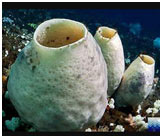An Introduction to Phylum Porifera
The name Porifera is derived from the Latin porus = pore, ferra = to bear.
Embark on a journey through the aquatic realms as we explore the intriguing world of Phylum Porifera – the humble sponges. This guide unravels the secrets of these primitive organisms, from their global distribution to the intricacies of their structure, reproduction, and economic significance.
Discover the unique characteristics that define Porifera, from their multicellular simplicity to the absence of true tissues and organs. Delve into the classification of sponges, understanding the diversity within classes such as Calcarea, Hexactinellida, and Demospongiae.
Learn about the economic importance of sponges, from their historical use in bathing to their modern applications in surgery and sound absorption. Uncover fascinating facts about their distribution, sizes, and distinctive reproductive strategies.
This guide serves as a portal into the underwater realm of Porifera, shedding light on the most primitive animals and their relevance in both natural ecosystems and human industries.
- 1) Distribution of Phylum Porifera
- 2) General characteristics of Phylum Porifera
- 3) Reproduction in porifera:
- 4) Classification of Phylum porifera
- 5) Calcarea or Calcispongiae
- 6) Hexactinellida or Hyalospongiae
- 7) Demospongiae
- 8) Economic Importance of Sponges
- 9) Summary
- 10) FAQs – Phylum Porifera
- 11) Wrapping up Phylum Porifera
- 12) You may also like to learn:
Distribution of Phylum Porifera
The Porifera are all pore-bearing creatures, commonly referred to as the sponges. All are aquatic. Sponges are globally distributed, living in a vast array of sea habitats, from the polar regions to the tropics. Many are living in silent, clean seas because sediment or rocks broken by waves could obstruct their pores, so which makes it problematic to allow them to breathe and feed.
Most of the sponges usually are found on hard surfaces such as rocks and stones, but a few sponges may hook themselves into soft sediment by means of a root-like base.
| This is part 3. See part 1 of this series: Classification of Living Organisms
See part 2 of this series: Classification of Kingdom Animalia |
Sponges are abundant but not as diverse in temperate waters than in tropical seas, perhaps because creatures that predate on sponges are richer in tropical waters. Glass sponges are the most frequent in temperate waters and at the depths of tropical and temperate waters, as their porous structure lets them extract food from these types of resource-poor waters with the minimum of work.
Demosponges along with calcareous sponges are diverse and abundant in shallower non-Polar waters. Out of absolute 5000 species, 150 species reside in freshwater whereas others are marine.
General characteristics of Phylum Porifera
Grade of organization: Sponges are composed of many cells hence are multicellular. But they are the simplest organisms. They have no tissue organization and lack organs.
Shape and Symmetry: Sponges lack symmetry or they are asymmetrical. They have various kinds of body shapes but the mostly cylindrical body and tube or vase-like.
Body cells:
Pinacocytes: Pinacocytes are the cells that made the outer layer of the body wall which is known as pinacoderm.
Choanocytes: Choanocytes are the flagellated collar cells that made the inner body wall layer which is known as choanoderm.
Amoeboid cells: The gelatinous mesenchyme present between pinacoderm and choanoderm contains amoeboid cells or spicules or sometimes called sponging fibers.
Spongocoel: The single cavity in the body of sponges, it is sometimes divided by choanocytes into chambers or canals.
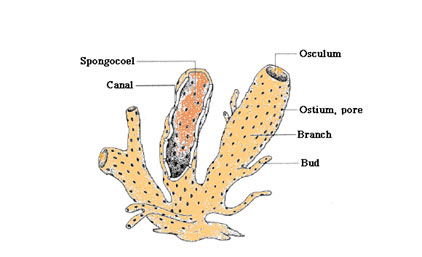
Size: The phylum Porifera ranges from few millimeters to more than a meter. So, some of them are macroscopic and can be seen by the naked eye.
| Do you know?
Scolymastra joubini-is more than a meter found in Antarctica
|
Ostia and Osculum:
The pores through which water enters in the body of the sponge are called Ostia and the pores through which the body emits water are called the osculum.
Organs and Organ Systems:
Sponges are the simplest organisms so they do not have respiratory or circulatory organs.
Movements: The adult poriferans are sessile and stationary spend their lives by attaching to rocks or stones. But their larvae are capable of swimming.
Because of the simplest organisms, they do not have nervous systems but neurons and neurosensory cells are present for the coordination of the body.
Endoskeleton:
These organisms have needle-like spicules (calcareous or siliceous) which act as endoskeleton and provides support. These spicules are also present around Ostia and osculum.
Reproduction in porifera:
Asexual: This type of reproduction is by budding. Buds may be external or internal. Internal buds are known as gemmules.
Sexual reproduction:
Some sponges are hermaphrodites.
hermaphrodites are those organisms which contain both male and female sexes.
Most of the hermaphrodite poriferans are protandrous, i.e. male sex cells develop first.
Fertilization: Fertilization is internal i.e. occurs in mesenchyme and zygote is formed. The embryo development includes blastula and larval stages.
Some common sponges are:
Sycon: It is a marine sponge.

Leucoselenia: A sponge that consists of a group of erect tubes.
Euplectella: It is a delicate sponge made up of a glassy framework and is commonly called Venus flower basket.
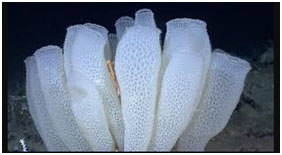
Spongilla: It is a freshwater sponge.
Classification of Phylum porifera
- Class 1: Calcarea or Calcispongiae
- Class 2: Hexactinellida or Hyalospongiae
- Class 3: Demospongiae
Calcarea or Calcispongiae
These are cellular sponges characterized by spicules made up of calcium carbonate. Generally, sponges of this class are small and mostly colorless or dull colored.
Example: Clathrina Clathrus
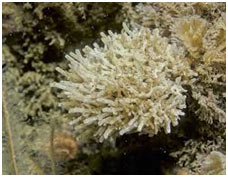
Hexactinellida or Hyalospongiae
Hexactinellid sponges are sponges having four- or six-pointed siliceous spicules, frequently known as glass sponges. They chiefly located at 450 to 900 meters in the depth of oceans.
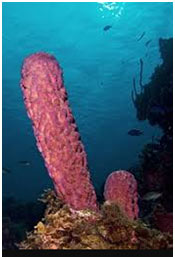
Example: Hyalonema
Demospongiae
This class is the most diverse class in phylum Porifera. Round about 76% of all sponges are demosponges. They are soft from inside but their outer layer is hard and made of calcium carbonate. They are mostly marine.
Example: Spongia officinalis
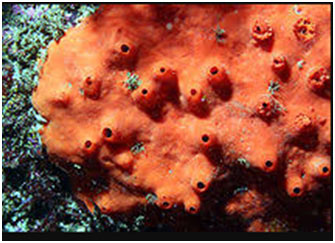
Economic Importance of Sponges
The skeleton of sponges has always been applied by men mostly for bathing and washing purposes. Even though a lot of artificial sponges are grown from synthetic material, but there is a great demand for pure natural sponges and is a significant industry in many regions of the world.
The finest commercial sponges are located in the hot waters of the Mediterranean Sea. Sponges have an amazing capacity to absorb water. They are utilized in surgical operations for absorbing fluids along with blood. Also, they are used for noise absorption in buildings.

| Do you know?
SpongeBobSquare Pants is also a sponge and the creator of this series was a marine biologist who animated the marine life in this series. |
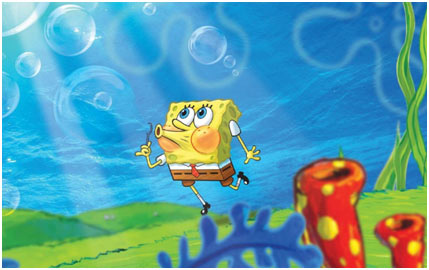
| This is part 3. See part 1 of this series: Classification of Living Organisms
See part 2 of this series: Classification of Kingdom Animalia |
Summary
Porifera from Latin word meaning pore bearing is the phylum containing all porous organisms with multicellular organization, simple asymmetrical and cylindrical body plan and are aquatic mostly inhabiting marine waters. The body of poriferan has specialized cells such as pinacocytes, choanocytes, and amoeboid cells.
There is a single cavity in the body called spongocoel. They can be from few millimeters to more than a meter. The pores through which water enters the body are called Ostia and through which exit the body is Osculum. They do not have a nervous system but neurosensory cells are present for coordination.
As the simplest organisms, they also do not have respiratory or circulatory systems. The adult poriferans are sessile and stationary but their larvae can move. Sponges are hermaphrodites but also reproduce by budding the asexual method of reproduction. There are three classes of this phylum 1) Calcarean 2) Hexactinellida 3) Demospongiae. Sycons are the common sponges in phylum Porifera.
FAQs – Phylum Porifera
- What does the name “Porifera” mean?
- The name Porifera is derived from the Latin words “porus” meaning pore and “ferra” meaning to bear.
- Where are sponges, belonging to Phylum Porifera, commonly found?
- Sponges, or Porifera, are aquatic organisms found globally in various sea habitats, from polar regions to the tropics. They are commonly found on hard surfaces like rocks and stones.
- What is the distribution pattern of sponges in temperate waters compared to tropical seas?
- Sponges are more abundant and diverse in tropical seas than in temperate waters, possibly due to fewer sponge-predating creatures in tropical regions.
- What are some general characteristics of Phylum Porifera?
- Sponges are multicellular organisms with no tissue organization or organs. They lack symmetry, have various body shapes (often cylindrical), and consist of cells like pinacocytes, choanocytes, and amoeboid cells.
- What is the purpose of ostia and osculum in sponges?
- Ostia are pores through which water enters the sponge’s body, while osculum are pores through which the body emits water after filtering.
- Do sponges have organs and organ systems?
- No, sponges are the simplest organisms and lack respiratory or circulatory organs. They do not have well-defined organ systems.
- How do sponges reproduce?
- Sponges reproduce asexually through budding, and some are hermaphrodites, meaning they have both male and female sexes. Fertilization is internal, and embryos go through blastula and larval stages.
- Can you name some common sponges and their classes?
- Examples include Clathrina Clathrus (Calcarea), Hyalonema (Hexactinellida), and Spongia officinalis (Demospongiae).
- What are the economic uses of sponges?
- Sponges have been traditionally used for bathing and washing. They are also utilized in surgical operations for absorbing fluids and blood, and for noise absorption in buildings.
- Are there different classes within Phylum Porifera?
- Yes, there are three classes: Calcarea or Calcispongiae, Hexactinellida or Hyalospongiae, and Demospongiae.
- What is SpongeBobSquare Pants, and why is it mentioned in the guide?
- SpongeBobSquare Pants is a fictional character and animated series. The mention in the guide is likely a playful reference, as the creator of the series was a marine biologist who incorporated marine life into the show.
- Where are the finest commercial sponges found?
- The finest commercial sponges are found in the hot waters of the Mediterranean Sea.
Wrapping up Phylum Porifera
The guide on Phylum Porifera provides a comprehensive exploration of these pore-bearing creatures, commonly known as sponges. Spanning their distribution, characteristics, and economic importance, the guide unveils the intriguing world of these primitive animals.
- Distribution: Sponges, found in aquatic environments globally, exhibit preferences for hard surfaces like rocks. The diversity of sponges is more pronounced in tropical seas, with glass sponges prevalent in temperate waters.
- General Characteristics: Sponges are multicellular organisms with a simple structure, lacking true tissues and organs. They come in various shapes, primarily cylindrical, and lack symmetry. The body is composed of pinacocytes, choanocytes, and amoeboid cells, with a central cavity called the spongocoel.
- Size and Movements: Ranging from millimeters to over a meter, some sponges are macroscopic. While adults are sessile, sponge larvae can swim.
- Reproduction: Sponges employ both asexual and sexual reproduction. Hermaphroditic in nature, they undergo internal fertilization, leading to the development of embryos and larval stages.
- Classification: The phylum is classified into three classes: Calcarea, Hexactinellida, and Demospongiae, each with distinct characteristics. The economic significance of sponges, used for bathing, surgical purposes, and noise absorption, is also highlighted.
- Cultural Connection: A humorous touch is added by mentioning SpongeBob Square Pants, connecting the scientific realm with popular culture.
In essence, the guide not only delves into the biological intricacies of sponges but also emphasizes their practical applications and cultural references. From their diverse forms to their impact on human activities, Phylum Porifera emerges as a captivating subject with both ecological and economic relevance.


